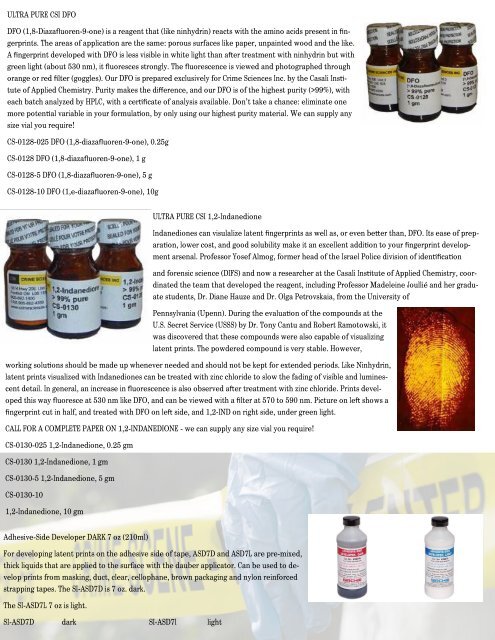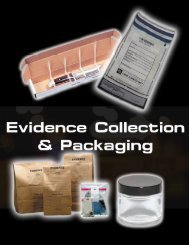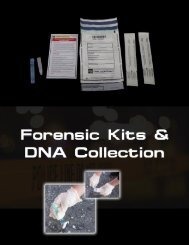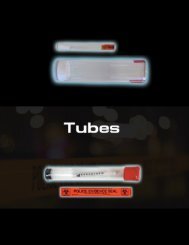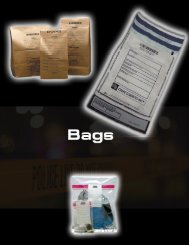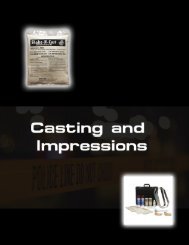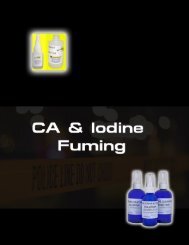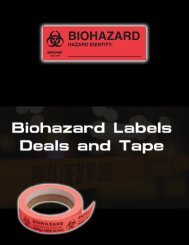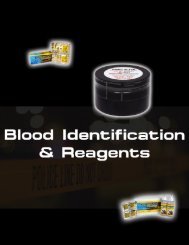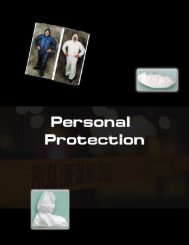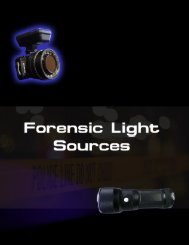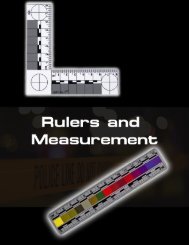Latent Fingerprints
You also want an ePaper? Increase the reach of your titles
YUMPU automatically turns print PDFs into web optimized ePapers that Google loves.
ULTRA PURE CSI DFO<br />
DFO (1,8-Diazafluoren-9-one) is a reagent that (like ninhydrin) reacts with the amino acids present in fingerprints.<br />
The areas of applica on are the same: porous surfaces like paper, unpainted wood and the like.<br />
A fingerprint developed with DFO is less visible in white light than a er treatment with ninhydrin but with<br />
green light (about 530 nm), it fluoresces strongly. The fluorescence is viewed and photographed through<br />
orange or red filter (goggles). Our DFO is prepared exclusively for Crime Sciences Inc. by the Casali Ins -<br />
tute of Applied Chemistry. Purity makes the difference, and our DFO is of the highest purity (>99%), with<br />
each batch analyzed by HPLC, with a cer ficate of analysis available. Don’t take a chance: eliminate one<br />
more poten al variable in your formula on, by only using our highest purity material. We can supply any<br />
size vial you require!<br />
CS-0128-025 DFO (1,8-diazafluoren-9-one), 0.25g<br />
CS-0128 DFO (1,8-diazafluoren-9-one), 1 g<br />
CS-0128-5 DFO (1,8-diazafluoren-9-one), 5 g<br />
CS-0128-10 DFO (1,e-diazafluoren-9-one), 10g<br />
ULTRA PURE CSI 1,2-Indanedione<br />
Indanediones can visulalize latent fingerprints as well as, or even be er than, DFO. Its ease of prepara<br />
on, lower cost, and good solubility make it an excellent addi on to your fingerprint development<br />
arsenal. Professor Yosef Almog, former head of the Israel Police division of iden fica on<br />
and forensic science (DIFS) and now a researcher at the Casali Ins tute of Applied Chemistry, coordinated<br />
the team that developed the reagent, including Professor Madeleine Joullié and her graduate<br />
students, Dr. Diane Hauze and Dr. Olga Petrovskaia, from the University of<br />
Pennsylvania (Upenn). During the evalua on of the compounds at the<br />
U.S. Secret Service (USSS) by Dr. Tony Cantu and Robert Ramotowski, it<br />
was discovered that these compounds were also capable of visualizing<br />
latent prints. The powdered compound is very stable. However,<br />
working solu ons should be made up whenever needed and should not be kept for extended periods. Like Ninhydrin,<br />
latent prints visualized with Indanediones can be treated with zinc chloride to slow the fading of visible and luminescent<br />
detail. In general, an increase in fluorescence is also observed a er treatment with zinc chloride. Prints developed<br />
this way fluoresce at 530 nm like DFO, and can be viewed with a filter at 570 to 590 nm. Picture on le shows a<br />
fingerprint cut in half, and treated with DFO on le side, and 1,2-IND on right side, under green light.<br />
CALL FOR A COMPLETE PAPER ON 1,2-INDANEDIONE - we can supply any size vial you require!<br />
CS-0130-025 1,2-Indanedione, 0.25 gm<br />
CS-0130 1,2-Indanedione, 1 gm<br />
CS-0130-5 1,2-Indanedione, 5 gm<br />
CS-0130-10<br />
1,2-Indanedione, 10 gm<br />
Adhesive-Side Developer DARK 7 oz (210ml)<br />
For developing latent prints on the adhesive side of tape, ASD7D and ASD7L are pre-mixed,<br />
thick liquids that are applied to the surface with the dauber applicator. Can be used to develop<br />
prints from masking, duct, clear, cellophane, brown packaging and nylon reinforced<br />
strapping tapes. The SI-ASD7D is 7 oz. dark.<br />
The SI-ASD7L 7 oz is light.<br />
SI-ASD7D dark SI-ASD7l light


